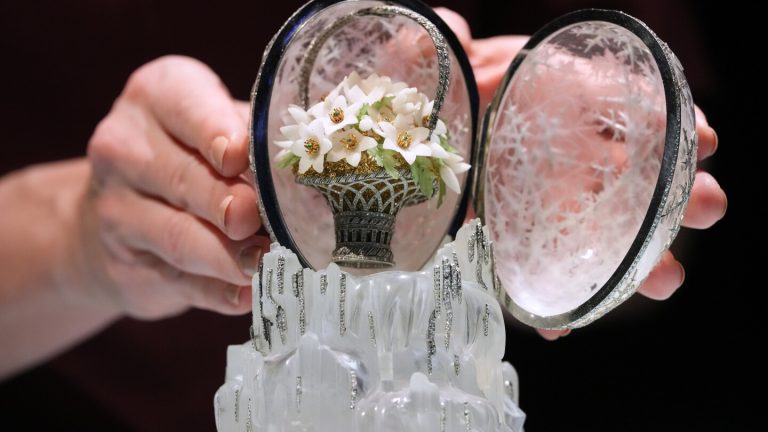LONDON (AP) — A rare crystal and diamond Fabergé egg crafted for Russia’s ruling family before it was toppled by revolution is going up for auction, valued at more than 20 million pounds ($26.4 million).
Christie’s auction house says the Winter Egg is just one of seven of the opulent ovoids remaining in private hands. It will be offered for sale at Christie’s London headquarters on Tuesday.
The 4-inch (10-centimeter) tall egg is made from finely carved rock crystal, covered in a delicate snowflake motif wrought in platinum and 4,500 tiny diamonds. It opens to reveal a removable tiny basket of bejewelled quartz flowers symbolizing spring.
Margo Oganesian, the head of Christie’s Russian art department, likened it to a luxurious Kinder Surprise chocolate.
The Winter Egg is a superb example of craft and design, “the ‘Mona Lisa’ for decorative arts,” Oganesian said.
One of just two created by female designer Alma Pihl, the egg was commissioned by Czar Nicholas II for his mother Dowager Empress Maria Feodorovna as an Easter present in 1913. Pihl’s other egg is owned by Britain’s royal family.
Craftsman Peter Carl Fabergé and his company created more than 50 of the eggs for Russia’s imperial family between 1885 and 1917, each elaborately unique and containing a hidden surprise. Czar Alexander III started the tradition by presenting an egg to his wife each Easter. His successor, Nicholas II, extended the gift to his wife and mother.
The Romanov royal family ruled Russia for 300 years before it was ousted by the 1917 revolution. Nicholas and his family were executed in 1918.
Bought by a London dealer for 450 pounds when the cash-strapped Communist authorities sold off some of Russia’s artistic treasures in the 1920s, the egg changed hands several times. It was believed lost for two decades until it was auctioned by Christie’s in 1994 for more than 7 million Swiss francs ($5.6 million at the time). It sold again in 2002 for $9.6 million.
Now it is expected to surpass the record $18.5 million paid at a 2007 Christie’s auction for another Fabergé egg created for the Rothschild banking family.
There are 43 surviving imperial Fabergé eggs, most in museums.


